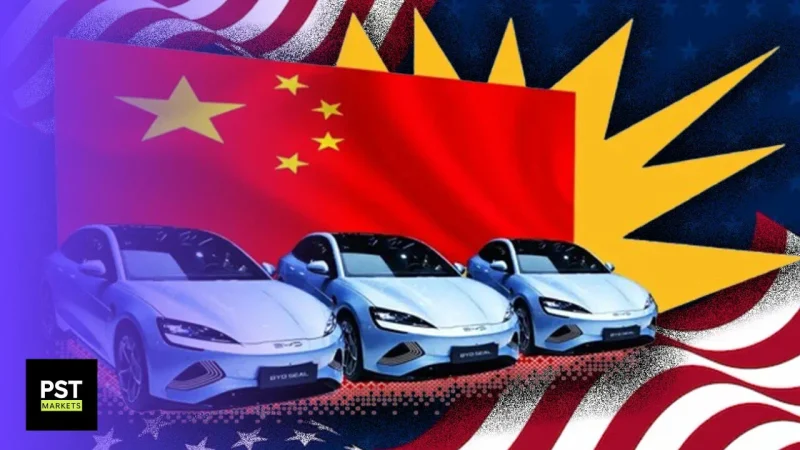The automotive landscape in the U.S. might be in for a strong shock. China’s leading EV company, BYD (OTCMKTS: BYDDF), could soon take the American market by storm, as it’s considering setting up a manufacturing plant in Mexico to establish an export hub to the U.S. and get around the sky-high American tariffs on Chinese imports.
BYDDF stock jumped 3.2% at the news, and many think it’s time for Tesla (NASDAQ: TSLA) to start looking over its shoulder, especially since BYD’s global EV sales surpassed Tesla’s for the first time ever, and now, with its sights set on the U.S. market that Tesla dominated for so long, it might snatch the crown there as well.
BYD’s Expansion Plans
BYD building a plant in Mexico will most certainly happen, as the news came from Zhou Zou, the manager of BYD Mexico. He said that the company is eager to build a car manufacturing plant in Mexico because overseas production is essential for expanding global presence and creating a strong international brand, and that’s exactly what BYD wants to do.
In fact, BYD already opened new facilities in Thailand this year, and announced plans in December of last year to build a production base in Hungary within three years. But, that’s not all, as the company is planning to spend $605 million to build a plant in Brazil. BYD has already launched a feasibility study for the Mexican plant, and is now negotiating with national and local government officials over a location and other terms for the plant.
Why Mexico?
BYD vehicles have been available in Mexico since early 2023. Therefore, building a manufacturing plant in Mexico isn’t meant to be BYD’s way of entering the Mexican market, but its way of entering the U.S. market. In Q4 of 2023, BYD managed to beat Tesla for the first time ever in terms of global EV sales, as it sold more than 500,000 vehicles while Tesla sold around 485,000. But, BYD’s sales are extremely concentrated in China, with exports accounting for only 8% of the 3 million-plus cars BYD sold in 2023.
And none of that 8% was to the U.S., because the American tariffs on Chinese car imports are 25%, an extremely high rate that was set by the U.S. government in the midst of the U.S.-China ongoing trade war, and one that the Biden Administration was considering to raise even more very recently. This means that it’d be very expensive for BYD to export to the U.S. directly from China, and the only way it can get into the U.S. market is through local manufacturing.
Since the requirements for U.S. tax breaks on EV purchases include assembly of the vehicles in North America, manufacturing in Mexico would mean lower export costs into the U.S. for BYD, as well as lower labor costs. In fact, Mexico’s manufacturing labor costs are 20% lower than in China, and it also offers steadier wages, so companies can more easily predict labor costs. Choosing Mexico rather than the U.S. is a very smart and strategic move from BYD, as a series of strikes that hit the auto industry in the U.S. over the past year have increased labor costs, so the wage gap between the U.S. and Mexico is expanding.
BYD v.s. Tesla
With this announcement, the clock started ticking for U.S. automakers and mainly Tesla, which is BYD’s main competitor in China and globally. BYD seems to be specifically targeting Tesla, as Zhou Zou didn’t mention where exactly in Mexico the company is looking for its new plant, but indicated Nuevo Leon and Bajio were likely candidates. It won’t be surprising if Nuevo Leon is picked, since it happens to be the same region where Tesla is building a new car plant.
Additionally, the strong competition from BYD in China has led Tesla to start cutting the prices of its vehicles over the past two years in the country, and the Chinese company ended up cutting its prices as well to be able to compete. This started harsh price wars in China that greatly impacted the country’s EV market, with BYD and Li Auto (NASDAQ: LI) being the only two Chinese companies reporting profits as everyone else lost millions.
Weakness in Tesla?
After making it through the Chinese price wars, BYD is planning on bringing the war to Tesla’s homeground. It’s likely that BYD is doing this now because it spotted a weakness in Tesla, and you could say that Tesla repeatedly cutting the prices of its vehicles globally, with the most recent cut being in the U.S. in the second week of February, when the company slashed the prices of its vehicles in the U.S. by $1,000, is by itself a sign of weakening demand.
Even though cutting prices helped Tesla sell a record 1.8 million cars in 2023, up nearly 40% from 2022, it resulted in the revenue growing at about half that pace, slowing steeply at the end of the year. In the company’s 2023 Q4 earnings call, Tesla also said that sales growth for the new year would be “notably lower” than in 2023, when deliveries rose 38%, and CEO Elon Musk even said that Chinese rivals “will pretty much demolish most other car companies in the world” unless trade barriers are put in place. This shows that Tesla is seeing the threat from its Chinese rival very clearly, and now it has around 2 or 3 years, which is the time it could take BYD to build the plant, to come up with defensive measures against BYD entering the U.S. market.
How Tesla Should Prepare
While Tesla is famous for its sleek designs and cutting-edge technology, BYD beats it when it comes to prices. BYD makes low-cost battery EVs and plug-in hybrid vehicles profitably, and it also makes its own batteries, which helps keep costs down. But, all the U.S. automakers have or are building battery capacity, which should nullify that advantage, and with that in mind, competitive success will boil down to product. In other words, to maintain market share in the U.S. and to not lose out to BYD’s consumer-friendly pricing, Tesla and other American automakers need to produce new lower-priced, attractive, electric vehicles.
Even though Tesla’s products are considered premium products, which justifies their high price tags, the company still recognizes the importance of the affordable EVs space, and is making its own entry into it soon. In fact, it’s currently working on its next vehicle platform which will be the basis of a battery electric vehicle that might start below $30,000, and that vehicle might be on the roads in 2025.
Other automakers in the U.S. are also opting for more affordable EVs. For example, General Motors’ (NYSE: GM) 2024 Chevy Equinox EV will be available in the middle of the year, and it starts at $35,000. Meanwhile, Ford (NYSE: F) is working on what it calls gen-two EVs now, and one of them will be a smaller, lower-priced EV.
The Risks Facing BYDDF Stock
American automakers shifting to manufacturing more affordable options could hurt BYD’s potential in the U.S., but it isn’t the only risk facing the Chinese company as it attempts to enter a new market. For starters, the global EV market is expected to slow in 2024, which is what caused Tesla to forecast significantly lower sales, and the case could be the same for other automakers including BYD.
The 2024 slowdown was already seen in January’s EV sales, with sales being down 26% from December in 2023, even though they were up 69% from January of last year. There’s also the fact that the former U.S. President Donald Trump, who started the trade war with China back in 2018 and is less than enthusiastic about the spread of EVs, could get re-elected in November. But, BYD’s representatives in Mexico brushed aside these concerns, saying that the adoption of the company’s EVs and plug-in hybrids are growing in every market worldwide. That doesn’t mean that BYDDF stock is completely risk-free, as it’s a Chinese company, and that makes it subject to substantial political risks regarding China’s strict regulatory landscape.
Another thing that’s worth thinking about is that BYD coming to the U.S. could force American automakers to stop fighting over market share and start making alliances. And it might be already happening, as General Motors’ CEO Mary Barra said her company would be willing to partner up with other automakers on technologies that are not consumer-facing, and form partnerships that would allow the companies to be more efficient with R&D as well as capital. She said that at the Wolfe Research Global Auto and Auto Tech Conference, in which the CEO of Ford, Jim Farley, also spoke and said that Ford would be willing to enter partnerships with other automakers in order to compete with the Chinese company, noting that if American automakers couldn’t compete with China, then 20% to 30% of their revenues would be at risk.
BYDDF Stock Forecast
The Chinese company had a very impressive 2023 despite the price cuts and strong competition, selling three million cars, its most ever, which is a whopping 62% increase from the previous year, and it’s forecasting sales in 2024 to rise to 11.5 million. Comparatively, Tesla sold 1.81 million cars, which is a 38% increase from the previous year, and it’s expecting sales to decrease.
This strong growth doesn’t take away the risk, but it could make BYDDF stock a good stock to own, especially since entering the U.S. market eventually could be a big catalyst. BYD is also China’s leading car company, and China’s EV market is the largest in the world, so even if it doesn’t turn out well for the company in the U.S., it still dominates China, which might make BYDDF stock a good pick for investors who don’t mind some risk.
Disclaimer
Please visit and read our disclaimer here.









